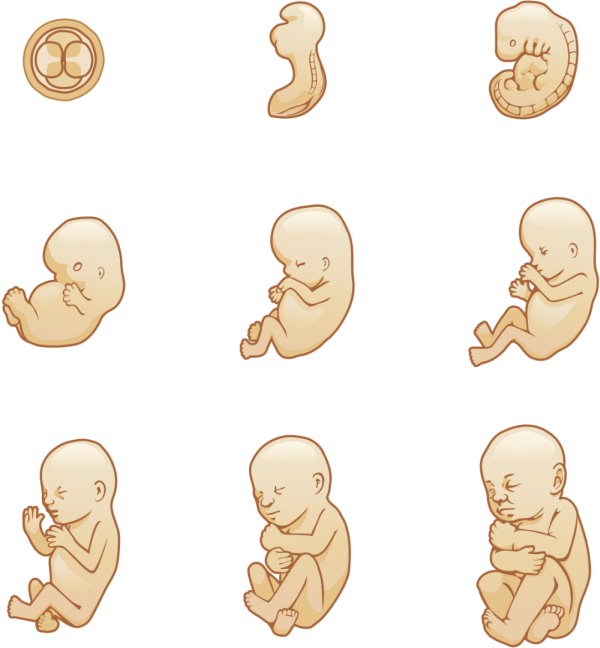Pregnancy Week by Week
It begins as a single cell on a journey – a journey that will end with death or life. On a path fraught with peril, it all depends on timing. If a woman’s egg, the ovum, encounters a viable spermatozoon or motile sperm, they will unite, and a new life will begin. If this does not occur, the egg will continue to travel until it is expelled from the woman’s body along with the unused lining of the uterus. The sperm will die, as well.
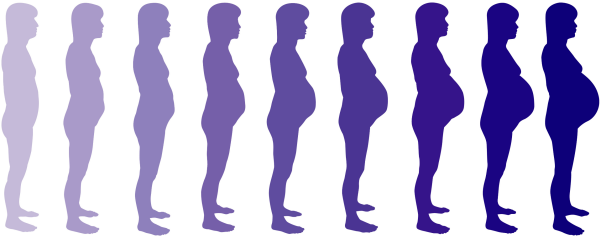
Life Begins
If the magic takes place, the fertilized egg, or zygote, begins its trip to the uterus that is waiting to receive it and offer it a chance at life. What follows is a detailed description of the development of what may, eventually, become a unique human being.
Germinal Period
Days 1-2 
Baby (zygote): The egg and sperm each contain 36 chromosomes (haploid cells). When they unite (conception), they create a single cell with 46 chromosomes (diploid). The fertilized egg continues down the fallopian tube where it is supposed to implant in the lining of the uterus if it is to live. Along the way, it repeatedly divides every 12-20 hours (mitosis).
Mother: Chances are, the mother is not experiencing any signs of pregnancy although some women do have morning sickness very early in their pregnancies.
Days 3-4
Baby (zygote): By the time the zygote is comprised of 16 cells (16 cell morula or pre-embryo), it should reach the opening of the uterus.
Mother: The mother may still not have any idea she is pregnant. Many women experience no symptoms during this stage of pregnancy especially considering the fact a pregnancy might not ever take place.
Day 5-8
Baby (blastocyst): The cells inside the blastocyst (embryoblast) will develop into the fetus while the cells outside (trophoblast) will become the placenta. It is at this time that it begins the process of attaching itself to the inside lining of the uterus (endometrium or womb).
Mother: It is likely the mother does not have any idea she has begun the first stage of pregnancy.
Day 9-11
Baby (blastocyst): By this time, the blastocyst has successfully attached to the endometrium. It is thought that more than half the eggs that get fertilized never complete the process of implantation. That may explain why some believe this is the beginning of the pregnancy. The beginning of blood circulation within the placenta begins. Taking a “morning after” pill before this time will prevent implantation and, thus, the pregnancy.
Mother: This marks the beginning of a pregnancy that has every chance of continuing. The mother may still not be aware pregnancy has begun.
Day 12
Baby (blastocyst): Hormones are being produced which are detectable.
Mother: Hormones can be detected in the urine at this time. Pregnancy tests can be used to confirm the pregnancy. Even a home test should be able to do accomplish this.
Days 13-14
Baby (blastocyst): The thread that will become the central nervous system appears. This is the last time that the blastocyst can divide in a way that can result in identical twins. The cells are undifferentiated at this point.
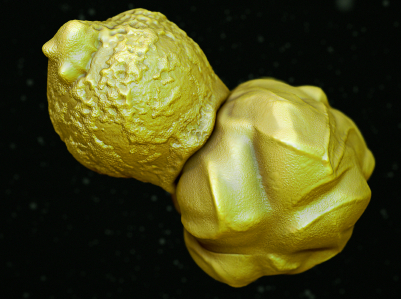
Mother: The mother may still not be aware a pregnancy has begun.
Embryonic Period
Day 15-21 (Week 2)
Baby (embryo): The baby continues to grow. During these days, it will change from a tiny dot point to something that can easily be seen by the naked eye.
Mother: Some women begin to experience subtle signs that pregnancy has started. It is more likely that women who have already had a baby will recognize the symptoms.
Days 22-28 (Week 3)
Baby (embryo): The baby measures about 1/12”. It looks like a little worm. It has a segmented end and appears to be slender and long. By now, there is a heartbeat.
Mother: By this time, a woman should be able to get positive results from a home pregnancy test. If her periods are very regular, she may realize she is late. Approximately half of the pregnancies that occur are unintentional, and about half of those end with abortion.
Days 29-35 (Week 4)
Baby (embryo): The embryo now resembles a tadpole. There is a tail, and the other end, what will become the head, is beginning to form. Gills, such as those that might be found on a fish, appear in the place that will, eventually, become the throat.
Mother: While many women are still not aware they are pregnant, it is possible to have tender breasts, more frequent urination, minor cramping, bloating and the feeling a period is about to start which is why many women may not realize they are pregnant. The symptoms of early pregnancy and an impending period are very similar.
Days 36-42 (Week 5)
Baby (embryo): Arm and leg buds have appeared. There are even tiny fingers, connected by webbing, that appear at the termination of the arm buds. It is even possible to get fingerprints. The brain, neurological and cardiovascular systems are in the primary stages of development. The face has a reptilian appearance. The tail is still apparent and the embryo, at this point, is indistinguishable from that of other mammals from the elephant to the rabbit.
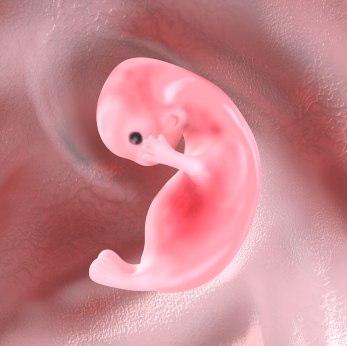
Mother: Some women experience some fatigue while other women notice nothing.
Days 43-49 (Week 6)
Baby (embryo): Now approximately 1/2” long, there are two eyes, and the area that will be the nose and mouth are marked with connected lines. The cranial nerves and brain are growing. It is possible the heartbeat can be observed during an ultrasound.
Mother: Fatigue is probably a little more pronounced, and you may now be experiencing morning sickness. Hormonal changes may result in more frequent headaches.
Days 50-56 (Week 7)
Baby (embryo): The tail is almost gone. It is possible to recognize the nose, mouth and lips. The face appears to be that of a mammal but most closely resembles a pig-like creature. The brain’s higher functions have not yet developed. While pain sensors have appeared, there is no way for them to send pain signals to the brain because those pathways, part of the nervous system, have not yet formed. Sex glands are growing, but it is not possible to see gender at this time. Toes and fingers may still have some webbing.
Mother: Naps may help with the fatigue. There may be changes in the feeling of skin and hair. In fact, it is possible to have worse acne at this time than during puberty. An unusual appearance of hair is common. While nausea and vomiting can cause weight loss, it should not be significant. If it is, a call to the doctor is in order.
Days 57-63 (Week 8)
Baby (embryo): Even though an embryo will respond to tactile stimulation, it is thought it has no consciousness. The primal part of the brain is beginning to coalesce. This will continue to serve for a lifetime. Baby teeth buds (primary teeth) appear. The optic nerve, visible ears, and eyelids develop at this time, as well. Baby is starting to move about, but this usually can’t be felt by the mother.
Mother: Clothes may feel a bit snug. Heartburn and indigestion may be a problem. Smaller meals and milk may alleviate these symptoms.
Days 64-70 (Week 9)
Baby (embryo): The muscles are developing all over the body. The heartbeat is becoming easier to monitor.
Mother: Hormonal changes may result in the mother feeling emotionally sensitive and irritable. Morning sickness and headaches can still be a problem. While some women may feel pregnant by now, not all women do.
Fetal Period
Days 71-77 (Week 10)
Baby (fetus): Now, the embryo is referred to as a fetus for the remainder of the pregnancy. It is possible to determine the gender by using ultrasound. Until now, the corpus luteum (the remainder of the follicle that covered the egg) produces progesterone. The placenta prepares to take over that function which it does as early as week 10. The baby’s head takes up about half of the baby’s mass. For much of a child’s youth, the head tends to be disproportionately large when compared to the rest of the body.
Mother: The mother’s body is beginning to prepare for birth and nursing. It is possible that a tiny belly may appear. Breasts may be fuller, areolas darker, and blue veins may become visible on the surface. For many women, the nausea and fatigue begin to disappear.
Days 78-84 (Week 11)
Baby (fetus): Nails are starting to form on fingers and toes. Baby boys are beginning to create testosterone. The bladder sac and intestines are starting to take shape.
Mother: From now on, there will be some weight gain if the baby is to be able to properly grow. The uterus is about the size of a softball. Drinking a lot of water is important and will help with headaches if they are still a problem. Hopefully, symptoms like nausea and fatigue are disappearing.
Days 85-91 (Week 12)
Baby (fetus): The fetus is beginning to make insulin and other hormones, and the liver is producing bile. The heartbeat is getting more discernible.
Mother: By now, some symptoms of pregnancy should be more noticeable. Concentration may be difficult, and stress can be a factor.
Days 92-98 (Week 13)
Baby (fetus): Intestines actually start developing outside the body. Now, they make the move toward becoming part of the abdomen as an internal organ. Tooth sockets are created, and hair follicles are developing, too.
Mother: The difficult signs of pregnancy should continue to lessen, and mothers become more comfortable. If this is not a first pregnancy, some women report being able to feel the baby move as early is the 13th week.
Days 99-105 (Week 14)
Baby (fetus): The baby is starting to breathe. It also is able to swallow amniotic fluid. These events signal the continued development of the lungs and digestive system. The intestines contain meconium which will become the baby’s first bowel movement. Meconium consists of bile, skin cells and amniotic fluid.
Mother: Sleeping may be a problem by now. Leg cramps are also possible which might partially account for the issues with sleep.
Days 106-112 (Week 15)
Baby (fetus): It is possible to determine a baby’s sex by observation by ultrasound. The skin is extremely thin which means blood vessels can be seen through the skin. Some babies start to suck their thumbs.
Mother: Some women are able to feel their babies move. Clothing can be a problem because regular clothes may be too tight, but maternity clothes are too big.
Days 112-118 (Week 16)
Baby (fetus): The fetus weighs in at about one ounce and is approximately three inches in length. It is possible to see fingernails and bones. The circulatory system is working, and sweat glands are developing. The eyes and ears are where they belong.
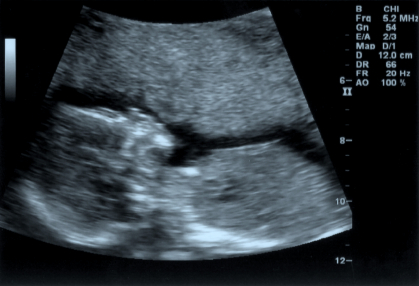
Mother: Some first time mothers can feel the baby move as early as the 16th week. Some mothers experience aching and back pain. Those who stand for long periods of time may experience these symptoms more profoundly.
Days 119-125 (Week 17)
Baby (fetus): Lanugo, the fine hair that covers the body and head, is appearing. Tooth enamel is starting to cover the teeth. A layer of fat is forming under the skin.
Mother: Some mothers have discomfort called round ligament pain. The growing uterus and stretching ligaments contribute to this sensation. Heartburn may be more likely, as well.
Days 126-132 (Week 18)
Baby (fetus): The bones are now getting harder. The ability to swallow and suck are becoming more comfortable for the baby. Finger and toe tip pads are development. Some babies start having hiccups which might result in jumpy actions.
Mother: Leukorrhea may appear. This is a thick, whitish discharge from the vagina. Gums may bleed while teeth are being brushed.
Days 133-139 (Week 19)
Baby (fetus): Permanent teeth buds now appear. The hands are able to grasp. The skin appears less transparent partially because of the development of a layer of fat under the skin.
Mother: Some women experience the swelling of their feet, especially those who stand and/or walk for long periods of time. Elevating the feet can help.
Days 140-146 (Week 20)
Baby (fetus): More than 90% of abortions are done prior to this time in the pregnancy. For the most part, they are prohibited from this point on. The baby is coated with vernix. This is a white, creamy substance. The nipples are visible. If this is a girl, the uterus has been created, and the eggs are in place in the ovaries.
Mother: Sleep can be interrupted. Nightmares are possible. Finding a comfortable sleeping position can be difficult. Because the baby is close to your lungs, shortness of breath can be a problem.
Days 147-153 (Week 21)
Baby (fetus): Eye lashes and brows start to grow. The kicks are becoming part of a pattern. The baby might take naps which would be evidenced by the temporary lack of kicks. The fetus weighs roughly half a pound and measures in the neighborhood of 8”. It is also getting easier to hear the heartbeat.
Mother: Many women report being able to feel the baby move. Women put on anywhere between a few pounds to as many as fifteen pounds. The majority of women know, by now, they are pregnant.
Days 154-160 (Week 22)
Baby (fetus): The baby is beginning to produce antibodies which are proteins. These antibodies are generated by the baby’s white blood cells. Their function is to fight disease and foreign materials.
Mother: By now, the sex drive is probably being affected by the hormonal changes of pregnancy. Some women report an increase in desire while others lose all interest.
Days 161-167 (Week 23)
Baby (fetus): The lungs are developing and will continue to do so throughout the remainder of the pregnancy. Alveoli are growing inside the lungs. These small sacs are found in the lungs and facilitate the movement of oxygen and carbon dioxide. The baby is beginning to develop reflexes including those of being startled and gripping with the hands.
Mother: The baby is larger and so is the mother. Braxton Hicks contractions can start now. These are painless, irregular contractions that are the result of the tightening of the uterus. They are often referred to as false labor. The baby may be applying pressure to the area surrounding the uterus.
Days 168-174 (Week 24)
Baby (fetus):
The eyes have finished developing and are fused shut, but they will soon be able to open. The skin is reddish and wrinkled. The majority of babies who are premature and reach this time of gestation will survive although they will experience severe complications and, perhaps, a lifetime of discomfort and distress.
Mother:
Braxton Hicks contractions may contribute to concerns about a premature delivery.
Days 175-181 (Week 25)
Baby (fetus):
This is a critical time in lung development because the alveoli are starting to create surfactant. Surfactant assists in the control of surface tension inside the lungs. This stops them from collapsing when the baby tries to breathe by keeping the lungs surfaces from sticking to each other. At this point, the baby is about one foot long and weighs about one pound.
Mother:
Weight gain is a little faster. Mothers may feel stiff and uncomfortable. Some women experience back pain to such an extent that they require a maternity belt to provide support. By this time, mothers should be able to feel the baby move.
Days 182-188 (Week 26)
Baby (fetus): Now the eyelids are no longer fused shut, but there is really nothing to see in the uterus. Still, the optic nerve is becoming functional. It is possible that at this time, a baby can respond to a bright light when it shines on the abdomen.
Mother: The pregnancy is becoming more of a challenge. While the baby has room, the kicking will continue. Shortness of breath may become more pronounced as the fetus grows and presses against the rib cage.
Days 189-195 (Week 27)
Baby (fetus): Hearing is developing, and it is possible the baby recognizes some voices. This recognition is sometimes observed in the newborn who responds those whose voices are remembered from the time in the womb. The retina has formed which means that it is likely the baby can more easily distinguish between light and dark. If the fetus is male, the testes are descending.
Mother: Some mothers experience pain in the sciatic nerve because of pressure placed on it by the baby. The mother’s movements can result in discomfort.
Days 196-202 (Week 28)
Baby (fetus): The baby is growing. Now, the survival rate and prospects for a positive quality of life are improving every day. The fetus is able to control body temperature to some degree.
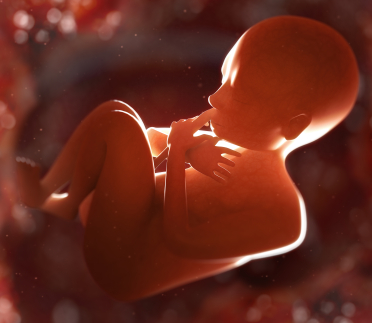
Mother: The discomfort continues, and visits to the doctor increase as the physician keeps a close eye on the possibility of premature delivery.
Days 203-209 (Week 29)
Baby (fetus): At 14” long and close to two pounds, the brain and lungs are developing. While the lungs have not completely matured, the bronchioles of the lung are growing, and rhythmic breathing is now possible. The brain is establishing neurons. Higher brain function is becoming evident in simple brainwaves which indicate some form of consciousness and, perhaps, pain. It is considered a sentient individual at this time, and some who consider themselves pro-choice consider this stage of development to be that of a human being. It is becoming quite cramped as the baby grows.
Mother: Discomfort increases, back pain may be more prominent, and shortness of breath may be more pronounced. The body is beginning to prepare for labor.
Days 210-216 (Week 30)
Baby (fetus): The baby has habits and preferences. While much time is spent sleeping including a period of REM sleep, there is a time when the baby is active and engaged.
Mother: Although the end of the pregnancy is still some weeks away, the breasts may be leaking colostrum. This is the first nourishment produced by the breasts. It is yellowish, creamy, as well as full of protein and antibodies. Even mothers who choose to not breastfeed consider providing this invaluable substance to their babies.
Days 217-223 (Week 31)
Baby (fetus): If the baby is a boy, the testicles may have made their way to the scrotal sac. Weight is being added at a faster pace. Iron, phosphorous and calcium are starting to be stored by the baby.
Mother: As the baby grows, the mother works harder. This can cause added discomfort in the form of aches and pains. If this is not the first pregnancy, the feelings can be more pronounced.
Days 224-230 (Week 32)
Baby (fetus): The skin is becoming more normal. The development of the kidneys is complete. The baby’s head should be positioned for birth by being down in order to present first during delivery.
Mother: Swelling is common. A woman can also experience a condition called preeclampsia with symptoms of headaches, blurry vision, or extreme swelling.
Days 231-237 (Week 33)
Baby (fetus): The baby may be cramped, but he or she is still moving. The baby is continuing to grow. The baby’s breathing results in inhaling amniotic fluid into the still developing lungs. Now about 16” long and almost three pounds, it is possible to see brain waves that are comparable to those found in adults.
Mother: By now, hemorrhoids may have appeared. Drinking plenty of water can help.
Days 238-244 (Week 34)
Baby (fetus): The head should be in the proper position for birth. The lanugo should be almost gone, but the skin may still be protected by the vernix.
Mother: The position of the baby is causing more discomfort. Hormones may be causing stress and irritability. There are only a few weeks left.
Days 245-251 (Week 35)
Baby (fetus): The fingernails extend to the end of the fingers. Lung development is relatively complete, and the lungs are creating surfactant. There would still be some problems with a premature birth at this time, but there is great success with time and treatment.
Mother: The cervix might start to dilate or efface at this time. It gets thinner as it prepares for the birth.
Days 252-258 (Week 36)
Baby (fetus): The baby’s head is descending into the pelvis as the time of birth gets closer. This is referred to as lightening as the date approaches.
Mother: It is possible that the vaginal discharge will escalate. It can contain mucous with a bit of blood. This is defined as a bloody show and can signify the very beginning of labor.
Days 259-265 (Week 37)
Baby (fetus): Now the baby is about18” long and weighs approximately five pounds. The baby continues to add weight. The breathing of amniotic fluid continues. A girl may experience a mucousy, pink vaginal discharge a few days after birth.
Mother: Pelvic pressure is increasing, and back pain may increase, as well. The doctor will continue to check for signs of impending labor. Some women may dilate early, while others will not until labor starts.
Days 266-272 (Week 38)
Baby (fetus): The baby is adding fat which assists in the regulation of body temperature and the protection of organs. The majority of the lanugo and vernix are gone as the baby is preparing to be born.
Mother: Contractions can begin even though labor has not. Once they begin to be regular, that is a sign that labor is, indeed, beginning.
Days 273-279 (Week 39)
Baby (fetus): This is the beginning of the end of a full-term pregnancy. All the organs are fully developed, but the baby will add fat until labor begins.
Mother: The cervix is starting to get thinner in preparation for labor. Discharge may increase. Once contractions are regular, the doctor should be notified.
Days 280-286 (Week 40)
Baby (fetus): Babies are born at a variety of lengths and weights. The average is about 7.5 pounds and 20 inches in length. A healthy, full-term birth can occur at any time.
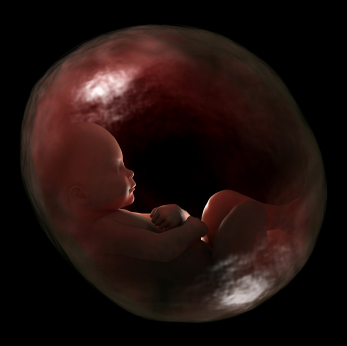
Mother: These last weeks are the most uncomfortable. Intermittent contractions can be experienced, and sleep can be very difficult. The body is either in labor or very close to being in labor.
Days 287-293 (Week 41)
Baby (fetus): The baby is ready to be born at any time. Babies are not born according to a schedule that is the same for all of them. Some are earlier, and some are a little later. This is still an appropriate time for labor to begin.
Mother: By now, the body is ready for labor, and it is only a matter of time before it begins. The wait is a challenge as the baby grows.
